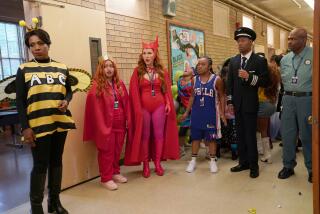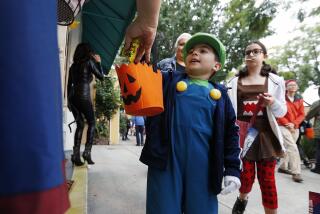. . . to Give Kids a Safe Halloween
- Share via
Allhallows’ Eve is still a time for frightful fun. In spite of problems that have marred the harvest holiday in the last few years, kids continue to dress up and parade through their neighborhoods in the trick-or-treat tradition.
Some families send their children toHalloween parties sponsored by local shopping malls and recreation centers. However you celebrate, you can help make the holiday safe and full of ghostly glee by taking some precautions.
One of the first considerations should be the costume. While a costume might look adorable on a youngster, it should also be safe.
A safe costume allows the child to move freely and see the immediate surroundings without any obstructions, according to Wanda Fudge, owner of Kids in Costume in Los Angeles.
Fudge, who designs year-round fantasy clothes for children, warns against using costumes made of plastic material, particularly for very young children. “It’s like putting on a plastic bag,” she says. “It doesn’t breathe, and the kids get hot and sweaty.”
Whenever possible, the costume should be light in color and decorated or trimmed with reflective tape, so it can be seen better at night. Reflective strips also can be used on a trick-or-treat bag.
The costume should be short enough to allow walking without interference.
A cape, says Fudge, should have Velcro fasteners so it’s easily pulled off. Ties can knot and choke a child.
Commercial costumes, wigs and beards should be labeled as “flame resistant,” according to the U.S. Consumer Product Safety Commission. While this does not guarantee that a garment will not catch fire, it indicates that it resists burning and is more readily extinguished if it does start to burn.
Young children shouldn’t wear masks, Fudge says, “because they “can’t see out of them. Face painting is what I would recommend.”
Makeup can inspire kids’ creativity, and they can help draw it on. Use theatrical-style makeup available at magic and costume shops, Fudge suggests.
Other sources of makeup are the Halloween kits sold at most variety stores and supermarkets or mom’s supply at home.
If a mask is used, it should have eyeholes large enough to provide full vision and a slot to allow the child to breathe freely. Mask ties should not bind the face or neck.
Special Accessories
Other costume accessories, such as swords, wands and staffs, should be made of flexible material and have rubber tips. Hats and wigs should fit securely so they don’t fall over the eyes.
Whether kids go trick-or-treating or attend a Halloween party, they should wear sturdy and well-fitting shoes. Adult high heels or large floppy shoes should not be worn because they can cause the child to fall and be injuried.
For trick or treaters, flashlights with fresh batteries are a must. Flashlights will illuminate the way at dusk or late evening and come in handy in case children get lost. Kids might also carry “light sticks” that glow.
No child should go trick or treating alone. Older children may go together in a group; younger children should be accompanied by an adult or responsible older child.
Kids should be cautioned to obey all traffic laws, cross the street at the corner and watch for cars coming in or out of driveways, and warned against running from house to house or walking in between parked cars.
Before eating any of their trick-or-treat treasures, children should wait until parents examine the contents of their goodies.
Throw away anything that looks stale or dirty. If candy looks as if it had been inserted into the candy or if you suspect tampering, call your local police department at the business number. Do not use 911, which is only for emergencies.
Many hospitals offer free X-rays of Halloween candy, but X-rays only reveal metal objects.
In preparation for Halloween, there are also safety measures treat givers should follow.
Keep a porch light on as a welcoming sign to trick-or-treaters. Walkways and yards should be cleared of objects that might cause children to trip.
If you set out a scarecrow or other stuffed goblin for decoration, make sure it’s securely in place. If you use lighted pumpkins or lanterns to mark the path to your home, make sure they are set far enough away that they won’t be knocked over and children’s costumes won’t make contact with the flames.
If you hand out candy this year, each one should be individually wrapped and the seal intact.
As an alternative, hand out inexpensive toys, such as stickers or erasers.
If you plan on carving a pumpkin into a jack-o’-lantern tonight or tomorrow, here are some tips from Genevieve Ho, the University of California Cooperative Extension home adviser and nutritionist:
Before carving or cleaning out a pumpkin, trace an outline at the top where you plan to make a cap. Kids, particularly younger ones, usually enjoy cleaning out the pumpkin with spoons; carving should be left to older children and adults.
Sketch the design with a pencil before carving and use the lines as guides. Use a sharp knife to avoid its slipping.
As an alternative to carving, you can paint a face on the pumpkin with markers.
Keeping the Shape
If you want to keep the pumpkin in its cut jack-o’-lantern shape for a while, shellac the outside skin. Be sure the shellac is dry before lighting a candle on the inside of the pumpkin.
Make an indentation on the bottom of the jack-o’-lantern, and fit the candle into it. Use a long fireplace match to light the candle.
Put aluminum foil over the inside of the cap, and then replace the cap loosely to permit some air flow to the candle.
Keep lighted pumpkins away from curtains, decorations and anything else that might be ignited.
After Halloween, if the pumpkin has not been shellacked, you can cut up the pumpkin meat to make a stew or soup. Just clean off any burned areas and candle wax.






